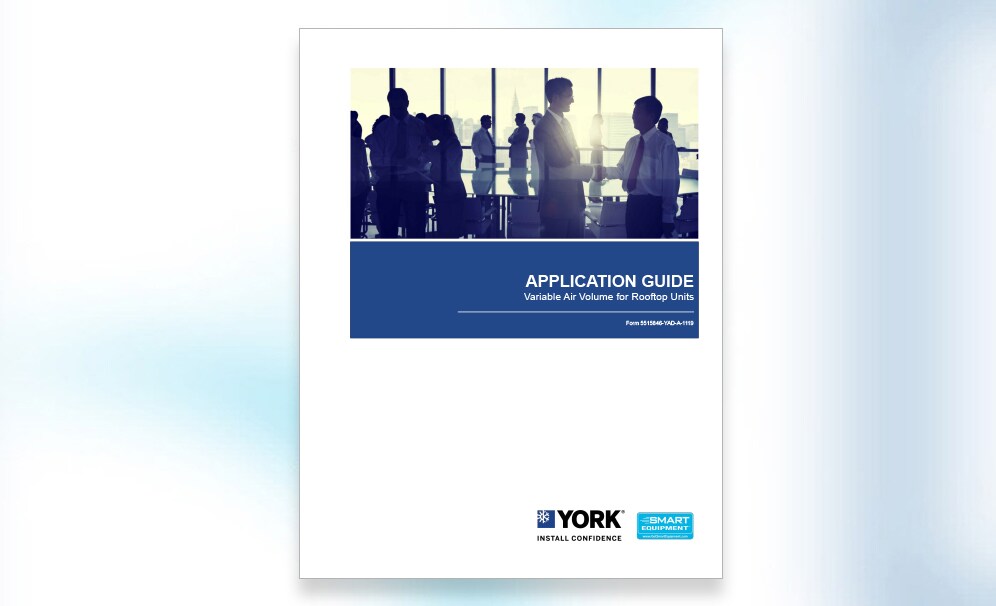How ASHRAE 90.1 Standards Affect Rooftop Unit Efficiency
Since 1975, the American Society of Heating, Refrigerating and Air-Conditioning Engineers (ASHRAE) Standard 90.1 has been a driving force in the improvement of rooftop unit (RTU) efficiency. Established as a benchmark for energy-efficient building design, the standard has been updated regularly since its inception, and remains the code official’s energy efficiency guide for most commercial buildings.
The Implications of Standard 90.1 for RTU Design
The Heating, Ventilating and Air Conditioning section of ASHRAE Standard 90.1 provides several options for standards compliance. The simplest route to compliance applies to single-zone, variable air volume (SZVAV) applications, while the second and third options focus on meeting either the mandatory provisions and prescriptive path, or the mandatory provisions and alternative compliance path (the latter of which focuses on computer room HVAC applications). The mandatory provisions and prescriptive path are most applicable for RTUs that feature variable air volume (VAV) control logic, such as those manufactured by YORK®.
If followed, studies indicate that adherence to Standard 90.1 will result in up to 8.3% energy cost savings, 7.9% source energy savings and 6.8% site energy savings in commercial buildings. In order to meet these goals, YORK® has relaunched our high-performance rooftop product portfolio, which includes class-leading, standard-efficiency levels and units that already exceed Standard 90.1-2019 and the more stringent DOE 2023 requirements. Available in 3- to 150-ton capacities, these units are designed to minimize installation and operating costs and come enabled with Smart Equipment controls. Each roof-mounted package unit has an exceptional combination of efficiency, performance and comfort.
The Implications of Standard 90.1 for RTU Design
The Heating, Ventilating and Air Conditioning section of ASHRAE Standard 90.1 provides several options for standards compliance. The simplest route to compliance applies to single-zone, variable air volume (SZVAV) applications, while the second and third options focus on meeting either the mandatory provisions and prescriptive path, or the mandatory provisions and alternative compliance path (the latter of which focuses on computer room HVAC applications). The mandatory provisions and prescriptive path are most applicable for RTUs that feature variable air volume (VAV) control logic, such as those manufactured by YORK®.
If followed, studies indicate that adherence to Standard 90.1 will result in up to 8.3% energy cost savings, 7.9% source energy savings and 6.8% site energy savings in commercial buildings. In order to meet these goals, YORK® has relaunched our high-performance rooftop product portfolio, which includes class-leading, standard-efficiency levels and units that already exceed Standard 90.1-2019 and the more stringent DOE 2023 requirements. Available in 3- to 150-ton capacities, these units are designed to minimize installation and operating costs and come enabled with Smart Equipment controls. Each roof-mounted package unit has an exceptional combination of efficiency, performance and comfort.
Understanding More About Standard 90.1 Compliance
The requirements outlined in Standard 90.1 must be met by the entire HVAC system, which might include the RTU, VAV boxes, building automation systems (BAS), ductwork configurations, fans and more. In addition, these minimum efficiencies must be met for all new equipment in a job site, as outlined in Standard 90.1 section 6.8. For rooftop units, Section 6.8 provides specific guidelines related to the minimum efficiency requirements of electrically operated unitary air conditioners and condensing units. In other words, there are a lot of factors that need to be considered.
Fortunately, YORK® rooftop units are engineered for efficiency with rooftop units that utilize variable-speed compressors, VAV control logic and other efficiency-enhancing technologies. To learn more about how YORK® rooftop units are engineered to meet or exceed the efficiency standards of today — and tomorrow — download your free copy of the complete Variable Air Volume (VAV) Application Guide for Rooftop Units.
DOWNLOAD APPLICATION GUIDE
Fortunately, YORK® rooftop units are engineered for efficiency with rooftop units that utilize variable-speed compressors, VAV control logic and other efficiency-enhancing technologies. To learn more about how YORK® rooftop units are engineered to meet or exceed the efficiency standards of today — and tomorrow — download your free copy of the complete Variable Air Volume (VAV) Application Guide for Rooftop Units.
